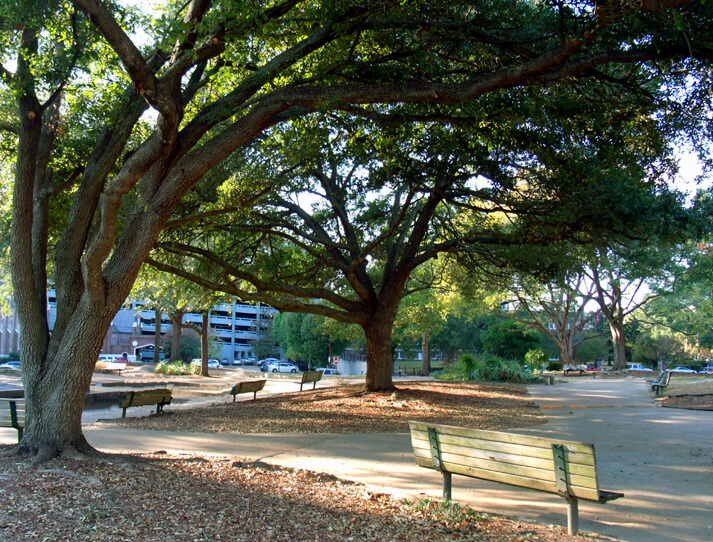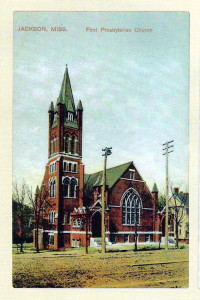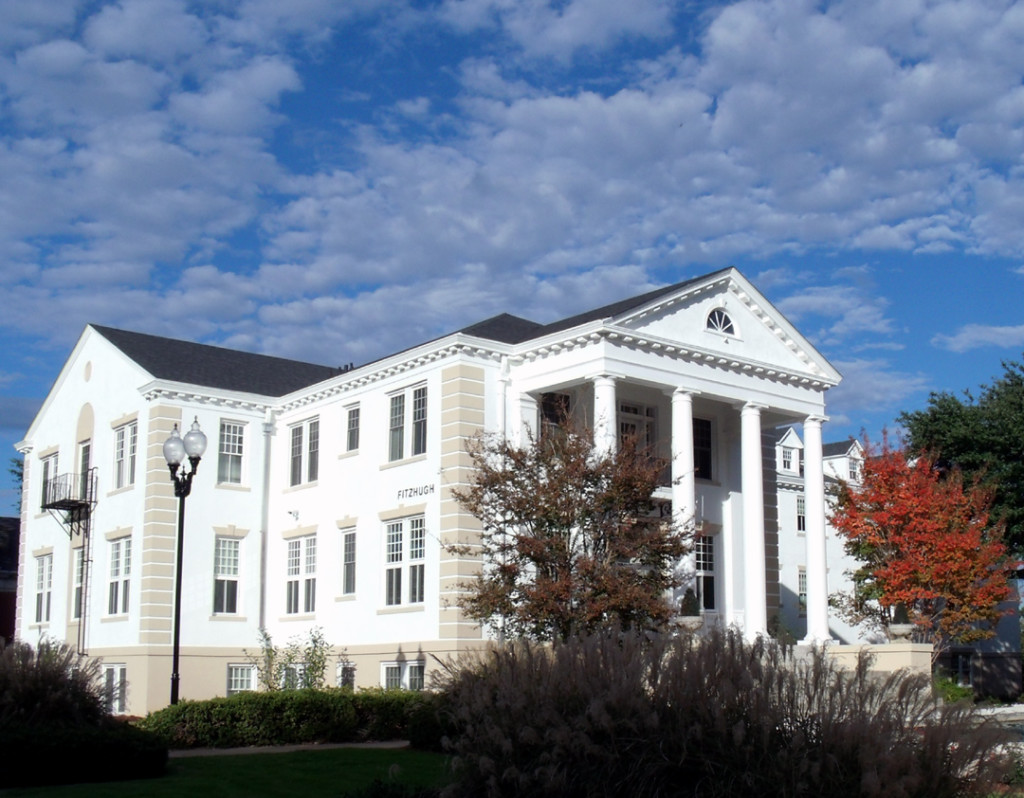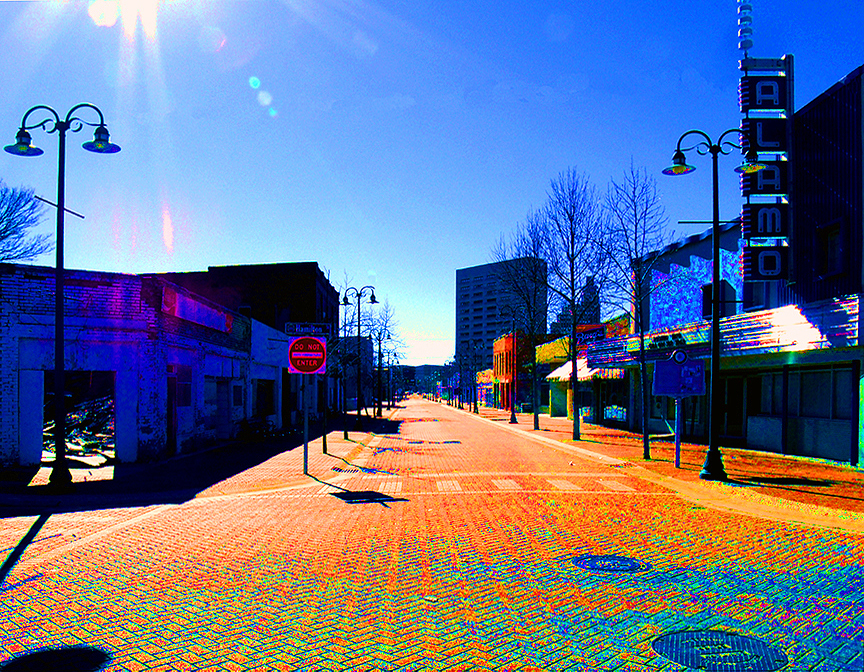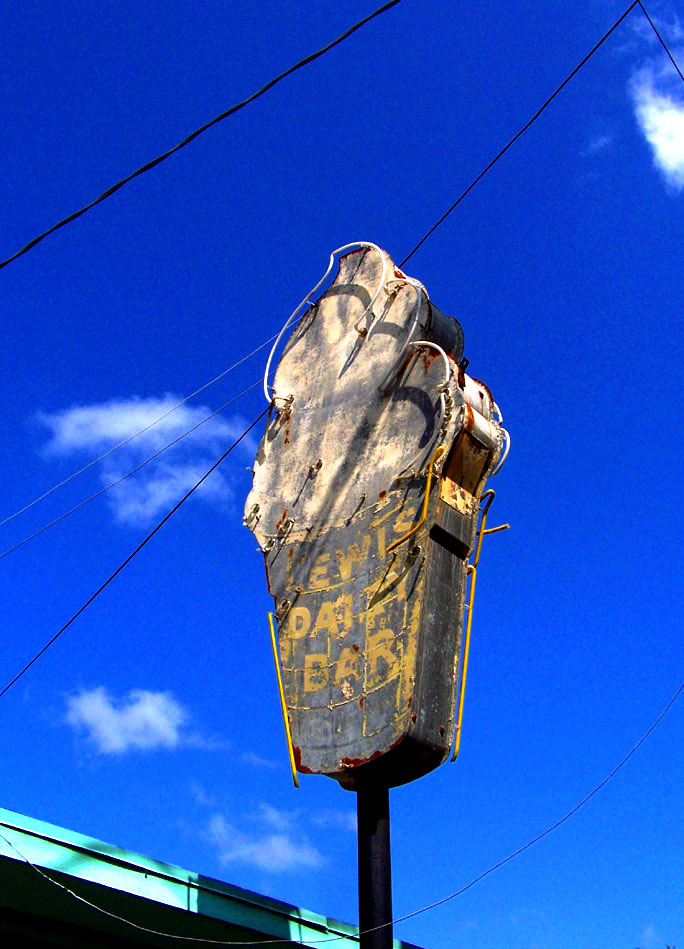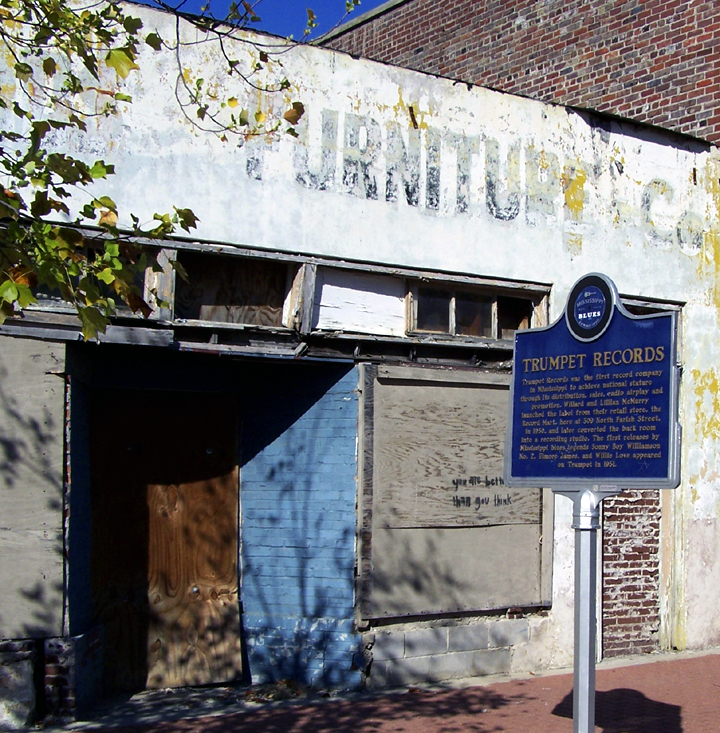Smith Park: A Mississippi Landmark
Smith Park is the oldest city park in the nation, and for that reason alone should be declared a Mississippi Landmark. In addition, although there has never been a formal archaeological study of the park, it represents the only undisturbed square in downtown Jackson and may hold as much archaeological value as a site as it does historical value as a park. Another compelling reason is that Smith Park is home to monuments of the state’s history and the capital city, monuments that deserve protection from the caprice and greed of municipal developers.
President Thomas Jefferson conceived of a basic municipal plan for Mississippi’s capital city in 1821, and Smith Park is the only remnant of his “checkerboard plan” that had a green space on every other square. The park was officially established on February 16, 1838, when the Mississippi Legislature voted to dispose of all unsold land given by the federal government “… except such blank squares as deemed necessary to be reserved as commons, for the health, ornament, and convenience of the city of Jackson.”
Smith Park is named for James Smith, Jr., son of James and Ann Preston Smith of Edinburgh, Scotland, who was born in 1816. Smith immigrated to the United States in 1832, and opened a hardware store on State Street in Jackson. Smith moved back to Scotland In the 1850s, due to his wife’s ill health. Smith became a millionaire from the sale of iron stoves acquired under the name of Smith’s Jackson hardware store and marketed in Great Britain and elsewhere by the firm Smith and Wellstood, Ltd. Smith died on April 11, 1886.
In May 1883, Jackson’s mayor and board of aldermen adopted an ordinance authorizing the mayor “…to solicit subscriptions of cash or donations of material for the purpose of putting a suitable fence around the square owned by the city in the rear of the Executive Mansion, and that he purchase a deficit of material needed, and at such time during the summer as he may select, that he enclose said square and put such gates as may be deemed necessary.” On January 1, 1884, Mayor John McGill wrote, “I mentioned the matter to a number of parties, and had promises of assistance, but received nothing from anyone except Mr. James Smith, a former resident of Glasgow, Scotland, who was here on a visit to his old home and friends. He gave me $100, $95 of which I paid on account of lumber purchased, and $5 to Mr. Phil Hammond on his account for building the fence.”
In the April 4, 1888, minutes of the Jackson city aldermen, a Mr. C.L. Gaston wrote: “Mrs. Gaston received a letter from Mr. James B. Smith, of Sterling, Scotland, informing her that he and his two brothers Messrs. Robert and William Smith had on hearing of the city’s improvement of the Public Park named in honor of their father, the late Mr. James Smith, of Glasgow, determined on contributing twelve cast-iron benches or settees.”
A bandstand was built in 1890, and Smith Park was open to black citizens as early as 1897. In the early 1900s, the bandstand was ordered repaired and the Jackson light and power company was asked to install lighting in the structure. Smith Park has always had a water feature, including at one time a goldfish pond and a fountain at the Amite-West Street entrance. On New Year’s Day, 1918, a pergola and fountain were erected on the southwestern edge of the park across from St. Peter’s Catholic Church as a memorial to one of Jackson’s most beloved citizens, W.J. Davis, “The man who led/Where others groped.” Davis founded the LaVernet Stock Farm near the outskirts of the city, “the means of which the advantages and availability of Jackson, Hinds County and Mississippi as a stock raising section was abundantly and decisively advertised to the world.” (Jackson Daily News, Thursday, Jan. 3, 1918, p. 6) This memorial, the oldest landmark in Smith Park, is still standing, but is not included in the proposed “renaissance” by the so-called “Friends of Smith Park” and Downtown Jackson Partners.
In April, 1934 the Order of the Eastern Star dedicated a memorial on the northeastern edge of the park to Robert Morris, whose home once stood across the park on Congress. Morris founded the Order of the Eastern Star at the Little Red Schoolhouse (Eureka Masonic College) in Holmes County. This monument to the founder of the Order is a shrine to its members, but it is not included in the “renaissance” proposal put forth by the so-called “Friends of Smith Park” and Downtown Jackson Partners, who clearly plan to destroy this vital piece of Mississippi history. Another significant landmark, the pavilion in the east central portion of the park, was constructed during the Depression, perhaps at the same time (late 1930s) as similar stone structures at the Jackson Zoo, including the former rhinoceros house, old concession stand, and old restrooms. This is the only landmark retained under the “renaissance” proposal.
On February 10, 1950, the Jackson Daily News declared, “Smith Park was donated to the city for park purposes and should be used only for park purposes,” purposes which surely include repose in the shade, leisurely walks and a soothing flow of water. In 1973, the park was redesigned, with wide walkways, an amphitheater featuring an A-frame band shell, a wooden stage with sunken seating area, and, the most beautiful and prominent feature, an artificial river designed by award-winning landscape artist and then city landscape architect Rick Griffin. This water feature includes a dramatic fountain on the northeast whose waters feed into a stream bed that encircles the park beneath walkways, in a flowing pool before the A-frame stage, ending on the southeast in a pool with a drain and pump that recirculates the water back to the fountain. The project was completed in 1975, the park re-dedicated that September. The “renaissance” proposal does not include a water feature and would also cut the oldest trees in the park, it’s only shade from the strong Mississippi sun.
In 1976, Smith Park was listed in the National Register of Historic Places, but this is insufficient protection for the oldest park in the state. Unless Smith Park is afforded protected status as a Mississippi Historical Landmark, the site will be subject to the whims of irresponsible municipal developers. It’s time to preserve the park as a shaded jewel in the state’s epicenter.
Blues Mural
First Pres: Our Cornerstone Church
“That realm is best and most stable which is ruled in accordance with God’s will alone,
and the worst and weakest is that which is ruled arbitrarily.”
Ulrich Zwingli
Jackson’s First Presbyterian Church (FPC) is a prime example of stability. It is located at 1390 North State between Pinehurst and Belhaven Streets. The current church, which opened in 1951, began its history 114 years before at the corner of N. President and E. Capitol Streets in Mississippi’s first state house building. Greater Belhaven’s only church was organized on a Saturday afternoon, April 8, 1837 by the Rev. Peter Donan and four persons: Mrs. Margaret E. Mayson, Mrs. Susan Patton and Mr. and Mrs. John Robb. There was a pastor (Rev. Donan), but no elders for two years, no deacons for six years nor an individual house of worship until 1845. In its first two years of existence, the church had but three new members. (1)
The State of Mississippi owned considerable land in the downtown area of Jackson in the early 1800’s. It made land available to religious denominations in the vicinity of Smith Park and First Presbyterian purchased a tract a bit north and east of the original designations at the corner of Yazoo and North State Streets. Its first home edifice was erected on this site in 1845-46. Somehow, it escaped the fiery ravages of General W.T. Sherman 18 years later and was razed in 1891. It was replaced by a small red brick building in 1893 (left) which served the congregation until the opening of the present structure in 1951. The final service in the old church was preached by Belhaven College President Dr. Guy T. Gillespie on August 26, 1951. (2) (3) (4) (15)
The land on which the church rests today (Hinds County MS parcel number 13-38), was owned by a group of developers in 1925. These were early Jacksonians S.S. Taylor, C.E. Klumb, S.K. Whitten Jr., W.N. Watkins and H.V. Watkins. This group sold the land on December 4, 1925 to W. N. Cheney, R.S. Dobyns, Carl L. Faust, W.E. Guild and Stokes V. Robinson. The Pinehaven Realty Corporation purchased the property from this group on March 1, 1927 for $12,700. (5) (6) (7) For the much of the following 23 years, Pinehaven Realty Corporation maintained the land where the church sits today. A single dwelling and out building were shown on the 1925 Sanford Fire Insurance map. The majority of the land between Pinehurst and Belhaven Streets was vacant and remained so until purchased by First Presbyterian Church on September 20, 1950. Prominent Jacksonian and church member Chalmers Alexander was instrumental in this transaction. (8) (17)
According to Jacksonian Judge Swan Yerger, much of this north end of the 1300 block of north state was a field which served as a softball diamond for the older Power School boys who were enrolled in the old Power School on Pinehurst. The spent their recess and many hours after school on this diamond. Since the inception of the church in 1837, First Presbyterian has had only 12 permanent senior ministers. The tenures shown below do not include interim or guest preachers.
Rev. Peter Donan – 1837-41
Rev. S.H. Hazard – 1841-42
Rev. Leroy Jones Halsey – 1842-48
Rev. Halsey built the first church sanctuary
Rev. Isaac James Henderson – 1849-53
Rev. L.A. Lowery – 1853-55
Dr. John Hunter – 1858-95
Dr. James Buchanan Hutton – 1895-1939
Dr. R. Girard Lowe – 1940-52: When this man knelt to welcome little children to Sunday School, he was a giant.
Dr. John Reed Miller – 1952-68: Dr. Miller was active in missions and in 1962, led the church in founding a Winter Theological Institute which was continued as Reformed Theological Seminary. For 16 years his sermons were broadcast on radio and beginning in the early 1960’s, the morning worship services were televised.
Dr. Donald B. Patterson – 1969-83: During Dr. Patterson’s ministry Twin Lakes Conference center was established near Florence and he served as chairman of the steering Committee that formed the Presbyterian Church of America. The PCA was Founded in 1973 and is focused on the infallibility and historicity of the Scripture and the Westminster Standards. According to Dr. William K. Wymond, minister of music and media, “We distinguish ourselves by these tenants.”
Dr. James M. Baird – 1983-95: Dr. Baird gave leadership to three new building programs, popularized the Church’s TV ministry and was instrumental in involving the church’s Mission Mississippi movement.
Dr. J. Ligon Duncan, III – 1996 – 2013: The son of an eighth generation ruling elder, Dr. Duncan recently resigned his pastorate to take over the position of Chancellor of the Reformed Theological Seminary. (1)
The Rev. David Strain took over the responsibilities of pastor in early 2015. Since that time several other worthy churchmen have helped fill the pews on Sunday morning. Today’s original sanctuary was opened Sunday, September 2, 1951 with the first service preached at 7:30 p.m. by interim pastor Dr. Albert Sydney Johnson. Additions to the original building have been the Lowe Fellowship Hall in 1956 which included additional Sunday School space, Westminster Hall in 1986 and Miller Fellowship Hall which contains the music suite, choir suite and kindergarten. A study center is located on the northeast side of the church which includes a gymnasium and three stories of Sunday School space. The present sanctuary was expanded in 2005-07 and currently seats 1,380. (2) (15) Since its inception 176 years ago, Jackson’s First Presbyterian Church has been housed in but three permanent buildings in three locations. It has been served by 12 elected ministers, for an average of just under 15 years each. This consistency is proof of the stability to which Zwingli alluded and is testimony of the continuity and permanence of this institution.
“And I say also unto thee, Thou art Peter, and upon this rock I will build my church;
and the gates of hell shall not prevail against it.”
Matthew 16:18
On July 10, 1950, while the present sanctuary was under construction, the church cornerstone, which dates from 1891, was transported from the old building on Yazoo Street to the left side of the new church’s front door. Dr. Girard Lowe oversaw the insertion of documents pertinent to the time. These included a bible, a church history, the church roll, various bulletins, a list of major actions leading to erection of the new building, names of the building committee, a roster of the major contributors up to that time, the departmental leaders and daily newspapers chronicling the event. (9)
The mission of First Presbyterian Church is that which is the answer to the question posed by the Westminster Shorter Catechism: “What is man’s chief end?” Man’s chief end and the mission of the church is “to glorify God and enjoy Him forever.” Today’s church is composed of over 3,100 members, 2,550 of whom are resident members that represent 1,375 families. Many currently live in the Belhaven neighborhood. There are 105 staff members including those at Twin Lakes Conference Center. The church is governed by a 70 member Session which is made up of elders. The minister’s role is to provide spiritual leadership. Property and care of the church is done by deacons. Ministers belong to the Presbytery. Major decisions are normally made by the Session with senior ministers selected by the congregation. Early growth of the church was overseen by its senior pastors and pioneer Jacksonians such as the Power, Williford and Wells families, Judge Julian P. Alexander, Bob Cannada, George Lemon Sugg and R.E. Kennington. Many leading elders and youth leaders have also contributed to church growth. (2)
“Those who have arrived at very eminent degrees of excellence in the practice of an art or profession have commonly been actuated by a species of enthusiasm in the pursuit of it.”
John Knox
The Presbyterian ministry throughout its history, which dates back to the Reformation, has been shaped by the knowledge of Christian faith and the principles of the history which surrounds it. Since the Reformation church leaders have placed a high premium on the education of its ministers and laity. A primary source of this knowledge is the Reformed Theological Seminary (RTS). The RTS was started in Jackson, Mississippi in 1966 by five men, four of whom were elders in First Presbyterian Church. Its purpose is to train for the ministry based on a high view of scripture and historic Westminster standards. With ancillary campuses in Orlando, Charlotte, Dallas and Washington, DC, it offers advanced degrees in bible studies, missions and family counseling. (10) Belhaven University has received significant support from FPC for a number of years.
A thriving institution today, Belhaven experienced some fallow years in the early and middle 1900’s involving its endowment and accreditation. In spite of the heroic efforts of its third president Dr. Guy T. Gillespie, the school struggled to maintain its viability. The designation of the college as a co-educational institution in 1954 helped the situation but it was its transfer by the Synod of Mississippi Presbyterian Church in the United States to the Belhaven College Board of Trustees in 1972 that ensured its modern independence. FPC elders serve on the College’s board and significant support is provided by the church. (11) FPC has historically supported private academies which base their mission on Christianity and character. Chamberlain–Hunt Academy in Port Gibson has a history that goes back to 1830 at Oakland College in Rodney. Founded as a military school, its fortunes waxed and waned through the years and were quite low in the mid 1990’s due to decreased enrollment. In 1996, members of the First Presbyterian church in Jackson and French Camp Academy in Choctaw County–in which the church also has an interest–purchased from a local bank the historic buildings, over 200 acres of land and the school’s educational equipment. This purchase ensured the viability of the Port Gibson facility at that time. (12)
Twin Lakes Conference Center near Florence was obtained in 1970. It serves as a summer camping facility in warm weather months and an events center the balance of the year. Over the years millions of dollars have been invested in this first class facility which is available for rental by outside groups. (13) FPC is youth oriented beyond Twin Lakes and its regular ministry. It supports the neighborhood Christian Center in the minority community which emphasizes Christian ethics, academic tutoring and breaking the chains of poverty. (2) Other outreach programs include work with Mission Mississippi, world missions, campus student groups and assistance in starting new churches within the PCA movement. The First Presbyterian Day School was established in 1965 and is located in Miller Hall on Pinehurst Street. The day school contains grades k-6 and currently has a student body of about 650. It involves normal school curriculum, which according to Dr. Wymond, “is based on a Christian and world life view.” It is designed so that the school and church complement each other. While this school can present some traffic challenges when taking in and letting out, it greatly strengthens the character of the neighborhood and is an attraction to numerous young families, many of which have remained in Belhaven after their children finish the sixth grade. (14) (2)
Let us not cease to do the utmost so that we may incessantly go forward
in the way of the Lord;and let us not despair of the smallness of our accomplishments.”
John Calvin“
When asked of the church’s future plans, Dr. Wymond stated “the First Presbyterian Church is always looking for opportunities to serve and preach the gospel. He further added, “No new projects are scheduled at present except to help the city. We are here for Jackson and as an institution to anchor the neighborhood, to conduct bible studies in the Mid Town neighborhood and be helpful and supportive of the church.” (2) On a rainy Sunday morning on the first day of October 1950, Billy Harvey, age 11, stood before the 400 member congregation in the little brick church on the corner and accepted Christ as his personal savior. He held a bible given to him by his parents and a Shorter Catechism provided by the church. Dr. Lowe asked the congregation to accept him into church membership and, standing, they agreed. Looking back through the prism of 63 years he would joyfully do so again. One hundred and seventy six years ago a pastor and four early Jacksonians met in a statehouse in a tiny city only 15 years in existence. They planted the seeds of a great church and a monument to their faith.
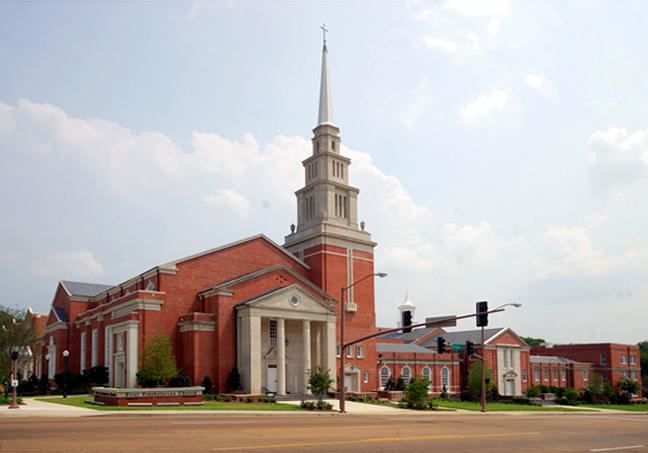
Today the First Presbyterian Church of Jackson rests firmly on its foundation, its steeple soaring toward the heaven we aspire to and towers over the memories of old Power School to the south on State Street and the rambling Green Apartments to the north. It surveys to the west what was at its construction the Hederman home at Marshall Street, the beautiful Vaughan Watkins house at Webster and Beth-Isreal Cemetery in between, ever facing east. Its mission remains the glorification of God. It is not moving to the suburbs. It is not changing its doctrine. It is not going away. Like Peter’s rock, it represents a hallmark of stability and is grounded in the inspiration of its purpose belonging to all as a beacon of faith, a citadel of strength and a cornerstone of our neighborhood.
Bill & Nan Harvey
September 2013
SOURCES
(1) Church history from web site
(2) Interview with Dr. William K. Wymond, minister of Music and Media, (09/30/13)
(3) Historic marker, NW corner of Yazoo & State Streets
(4) FPC archives
(5) Hinds County deed records, book 174, page 22, (12/04/1925)
(6) Hinds County deed records, book 190, page 284 (03/01/1927)
(7) Hinds County deed records, book 676, page 87 (09/20/1950)
(8) Jackson city directories 1930-50
(9) Program, Laying of the Cornerstone, FPC, 07/10/1950
(10) Reformed theological Seminary, Internet Wikipedia, (09/04/2013)
(11) Gordon, James F., Jr., A History of Belhaven College 1894-1983, Jackson, MS Belhaven College (1983)
(12) Chamberlain-Hunt and French Camp Academies web sites
(13) Twin Lakes Conference Center web site
(14) Mission Statement, FPC Day School, A Kingdom School, Established 1965
(15) Jackson Daily News, Sunday 8/26/51
(16) Conversation with Judge Swan Yerger (09/29/13)
(17) Sanford Fire Insurance Company map – 1925
ACKNOWLEDGEMENTS
(A) Thanks are extended to Dr. William K. Wymond, minister of Music and Media at First Presbyterian Church for his kind contribution of time to explain much of the background of today’s church
(B) Appreciation is extended to Rev. Brister Ware, minister of Pastoral Care for his efforts to coordinate permission and approval of this article
(C) Appreciation is extended to the senior pastor and others associated with the governmental structure of First Presbyterian Church of Jackson for their support and approval of this article.
Belhaven: Our Neighborhood University
Belhaven University has been around for a little over 120 years – longer than the neighborhood in which it resides and only five years removed from the beginning of neighboring Millsaps College. The college began as a girl’s school, progressed to co-educational sixty years later, burned three times, and merged with an institution that no longer exists. It provided pasture for cows in its early days and boasts campuses throughout the southeast today. But I may be getting ahead of myself. Let’s start at the beginning.
Who Was Dr. Fitzhugh?
Dr. Louis T. Fitzhugh (1841-1904) was the founder of the modern Belhaven College and served as its initial owner and first president. He came to Jackson in 1894, following a successful career as president of Whitworth College in Brookhaven. He had previously been a member of the faculty at the University of Mississippi. He launched Belhaven as a private school for girls and was influenced in his academic endeavors by Millsaps College and his association with the W.B. Murrah family. Fitzhugh’s new school was named for the old Belhaven mansion purchased from Colonel Jones Hamilton. 
Fire and Fate – Historical Twins
Three separate fires played a major role in the College’s early history. Belhaven was chartered as a private, one owner (Dr. Fitzhugh) institution in 1894. It was designed to be a four-year girl’s school. It was located in Dr. Hamilton’s deeded mansion on Boyd Street (now the 900 block of Bellevue), and was called Belhaven College for Young Ladies. This structure was totally destroyed in a massive fire on February 7, 1895 and replaced the following year with a single dwelling frame structure on the same site.
Mrs. J.R. Preston, wife of Belhaven’s second president, remembered in a mid-20th century address details of the first early campus. “As I recall the scenes of Belhaven as I first knew it, the white buildings with green blinds came before me, the two story dormitory and school building as one, with a porch adorned with attractive grill work, running along the front; the cupola rising above all, by its presence. I see beautiful, far-reaching views to be seen from all buildings for there was no northeast Jackson then. 
Dr. Preston (1853-1922) came to Belhaven from his presidency at Stanton College in Natchez. He was a former State superintendent of education and largely responsible for the public education system in place in Mississippi today. The State’s official motto Virtute et Armis (Valor and Arms) was coined by Preston and has appeared on the Mississippi coat of arms since 1894. A second devastating blaze began on October 19, 1910, from a furnace spark which landed in the dining room of the main building. According to Mrs. Kenneth Kraft and Mrs. Henry Mills, Dr. Preston’s daughters who witnessed the fire as children, the October day was dry and windy. The fire wagons came immediately, but the hydrant was at the foot of the hill. With no water pressure, nothing could be done. Preston decided for business and personal reasons not to rebuild Belhaven. He discussed his decision with his pastor J.B. Hutton of First Presbyterian Church in Jackson. As a result, the Presbytery received as a donation by Preston title and charter to the school which was renamed the Belhaven Collegiate and industrial Institute on July 25, 1911. The Boyd Street site was abandoned and construction began on a new academic building on the corner of Harper and Park Streets– later to be renamed Pinehurst and Peachtree. Belhaven Street, to reach from the center of the campus to North State, was a dotted line on the maps of the day, a dirt road and as they say “only a gleam in the eye.” Fate would intervene again in a number of ways 16 years later. (3), (4), (5)
How Did Fitzhugh and Preston Halls Get Their Names?
On August 9, 1927, lightning struck the main building and destroyed the major part of the plant and most of its contents. This was the building facing Peachtree Street which housed dormitories on the first and second floors, a kitchen and dining area on the north end and a chapel and gymnasium on the south. One can only imagine what went through the mind of President Guy T. Gillespie as he received a Western Union wire while on board a train to Princeton University to deliver a speech. It appeared at first that the building was a total loss. Yet from the ashes of that summer day rose the phoenix of the modern day Belhaven University. It reset the course of the school’s history. The board of trustees met the following day and began plans to rebuild. Meanwhile, Gillespie had plans of his own. While taking an architecture course at Columbia University, he was required to do a design project. He applied this experience to the task at hand. He never really liked the campus being all one building and so he developed a plan for taking out the burned center section creating two distinct buildings which are Fitzhugh and Preston Halls today. Between the buildings was built a concrete lagoon with columns on either side. The beautiful lighted fountain which can be seen from far down Belhaven Street stands in this location now. (3) (6) (7)
The Years of Famine
Dr. Guy Gillespie began his presidency in 1921 and remained as head of the college for 33 years. He faced nearly insurmountable challenges in areas of endowment, enrollment and accreditation during his tenure. It would be no stretch to say that while Fitzhugh and Preston fathered the institution, Gillespie saved it during its formative years. The battle for accreditation, the lifeblood of every serious educational institution, began in earnest at a May 21, 1929 meeting when Gillespie announced to his board that the Southern Association of Colleges and Schools had denied accreditation to the school. Their reasons were that endowment was $100,000 short of the required amount, the library needed 2,000 additional books, faculty salaries were far below the Association’s minimum and the faculty included only one Ph.D. The following 25 years were a testament to tenacity, endurance, courage and prayer. While church, local municipalities, out-of-state funding sources, local businesses and private individuals did their best to help the college meet its endowment needs and other accreditation criteria, there was a depression to contend with followed by a world war.
Through perseverance and God’s help on the morning of June 1, 1946, Gillespie was able to read the following statement to his board: “The outstanding event of the year was the admission of Belhaven College to membership in the Southern Association of Colleges and Secondary Schools at the annual meeting of the Association in Memphis on March 28, 1946, and with the full accreditation of the institution as a standard liberal arts college.” Academically, Belhaven was legitimate. Its future was secured. Other historical landmarks were the designation of Belhaven as a co-educational institution in 1954, transfer of the college by the Synod of Mississippi Presbyterian Church in the United States to the Belhaven College Board of Trustees in 1972, and renaming the college Belhaven University in 2009. (3)
A Historical Anomaly
While many consider the birth of Belhaven as 1894, when Fitzhugh purchased the Hamilton property and received a charter for the establishment of the school, others point to 1883 as the beginning. Technically, others are correct. We have discussed the college’s difficulties with achieving accreditation which hindered its growth and academic credibility. One means of addressing this deficiency was a merger with the Mississippi Synodical College in Holly Springs on April 14, 1939. Consolidation of the two colleges took place under the following terms:
(1) Mississippi Synodical College would not close (but eventually did), but continue as a part of Belhaven College.
(2) Consolidation would take place as of June 1, 1939, and the Belhaven College Board would assume functions of the Mississippi Synodical College Board of Trustees.
(3) Assets and liabilities of the Mississippi Synodical College would be taken over by Belhaven.
(4) The Christian aims of both colleges would be preserved.
(5) The endowment, assets, and other permanent funds of Mississippi Synodical College would be kept intact and used as nearly in accordance with the intention of the original donation as possible.
(6) After liquidation of the outstanding indebtedness of Mississippi Synodical College, the residue would be used in the construction of a building or in some way to perpetuate the name of the college on the campus of Belhaven.
(7) Records of the Mississippi Synodical College were to be preserved at Belhaven.
(8) Dr. Robert Franklin Cooper, president of Mississippi Synodical College, was named vice-president of Belhaven.
Mississippi Synodical College opened in 1883. This date was adopted by the Board of Trustees as the founding date of Belhaven as it represented the oldest founding date of all of the institutions (Belhaven had merged with the McComb Female Institute when it was reopened by the Central Mississippi Presbytery in 1911), which were eventually absorbed into the college. (3) (8)
Today’s Belhaven
Belhaven University has come a long way from Fitzhugh’s dream of a Christian girl’s school in 1894 and that hot, windy afternoon in 1910 when Preston’s daughters watched fire consume that dream a second time only leading to a third. The college has survived three fires, a depression economy, elusive accreditation, myriad ownership and four name changes.
Today’s Belhaven University is a private four-year liberal arts institution and sits on a main Jackson campus of 42 acres bounded by Peachtree Street, Pinehurst and Greymont Avenues and Belvoir Place. It is composed of 13 classroom, dormitory and administrative buildings, a lake, a bowl, a pavilion, a commons and a lighted fountain. An Alumni Center is located on the west side of Peachtree Street near Riverside Drive. Every four years the City of Jackson hosts the International Ballet Competition and Belhaven University provides lodging for a majority of its participants from throughout the world. According to the Department of Communications, there are a total of 3,500 students, 1,100 traditional, with 500 living on the main Jackson campus, with 300 adult students on the Lefleur Campus. Seventeen hundred adult studies and graduate students are enrolled on campuses in Memphis, Houston, Orlando, Chattanooga and Atlanta, plus participating in a growing online program.
There are 27 undergraduate studies programs on the Jackson campus and five graduate studies programs including degrees in business and public administration. The ASPIRE Program, located in a facility on I-55 north in Jackson, provides an encouraging educational environment where adult graduate students can complete their degree programs while maintaining their careers and personal lives. The school competes well in the NAIA’s Mid-South and Southern States Athletic Conferences and the Baseball Blazers are looking forward to a stellar season this spring. A total of 17 bachelor and 13 graduate programs are housed on ancillary campuses in cities mentioned above. Associate degree programs are available on these sites as well. There are also extensive online studies available to the modern student. Remember back in 1929, when the library was 2,000 books short, insufficient for accreditation? The Hood Library now has 115,000 volumes and 500 periodicals. The Jackson campus has a faculty in excess of 90 professors and instructors, 20 of whom are Ph.Ds. The school has an endowment just under $5 million. (10) (11)
What Can We Do?
What can we do as a neighborhood to support this institution we see in many ways as our own? We can reflect a moment and ask ourselves some questions.
Have you spent some time on the campus walking trails lately to see all the new construction? Have you spoken with students or faculty members or walked along the lake by the practice fields and noticed the ducks and an occasional fisherman on a Sunday morning?
Did a friend or relative attend Belhaven back in the day; are they students now or plan to be?
Did you sit with your mother as I did as a child in the 1940’s by the lagoon filled with goldfish between Fitzhugh and Preston Halls and listened to her tell you of her own college days at Belhaven in the 1920’s? (She and the goldfish are gone but the memories and a magnificent fountain remain.)
Have you or those you know of a later generation visited Bitsy Irby Visual Arts and Dance Center at Peachtree and Euclid Streets, the Entergy Pavilion down the hill from the Bailey Commons or the Belhaven College of the Arts with its magnificent ballet performances on the western rise of Riverside Drive for an evening of cultural enrichment?
Did you know Eudora Welty who lived across the street? Do friends have coffee in her Shoebird Café in the McCravey Triplett Student Center? Did they visit the bookstore?
Have you done reading or research at the Warren Hood Library or voted in its Barber Auditorium?
Have you sat on the white benches along the faculty walk in Gillespie Commons?
Do you know anyone who built a home in Belhaven in the 1950’s or 60’s on Belvoir and knew it was once the northern shore of Belhaven Lake?
Did you swim or canoe in the lake as a kid or today watch its fountains display theior beauty near the practice fields?
Did your gang play football or baseball as children the bowl on Peachtree or watch your own children play soccer there only last week?
Have you seen or listened to the school’s free gift of the beautiful Belhaven Christmas Tree singing each season by the lake?
Have you or one of your friends bought a home in the neighborhood and in some cases spent more on renovation than the purchase price just so you can live here? Do we as residents and friends fully understand who gave our neighborhood its name?
Do you feel a sense of pride when people ask you where you live and you can tell them “Belhaven”?
There is always something which can be done to preserve a heritage of faith, courage, achievement and vision. There are commitments to be made, memories to be acknowledged, friends and associates to influence and work to be done. Dr. Fitzhugh will take the time in his eternal classroom to open to us his own book of life and acknowledge our support so that perhaps his hall and college will remain with us another hundred years attesting to the excellence of Christian good will. We have in Belhaven University a treasure and cornerstone to one of America’s great neighborhoods. You do not even have to go to school to realize how fortunate we are.
Bill Harvey
February 2012
Sources
(1) Parrott, Roger, “Letter to Alumni and Friends of Belhaven” (December 2011)
(2) Gillespie, G.T., Dr. Louis T. Fitzhugh, Commencement Address (1954)
(3) Gordon, James F., Jr., “A History of Belhaven College 1894-1981”, Jackson, MS, Belhaven College (1983)
(4) Preston, Mrs. J.R., “Memories of Early Belhaven”, speech (undated)
(5) Belhaven College, Sanford Map Company, sheet 19 (1918)
(6) Waibel, Paul R., “Belhaven College,” Charleston, SC: Arcadia Publishing Co. (2000)
(7) Parrott, Roger, “Thinking About Higher Education” Belhaven Tartan: (Winter 2011)
(8) “Belhaven University”, Wikipedia Encyclopedia (January 2012)
(9) Parrott, Roger, quote from e-mail (1/13/12)
(10) Belhaven University Department of Communications
(11) Belhaven University website
Acknowledgements
Greater Belhaven Neighborhood Foundation Executive Director Virgi Lindsay for the idea
- Henry Mills, M.D., grandson of Dr. and Mrs. James Rhea Preston for his kind hospitality and for sharing personal documents as to the early history of Belhaven
- Bryant Butler, Director of Communications, Belhaven College, for invaluable information on Dr. Louis Fitzhugh, photograph reproduction of the Hamilton Mansion and current Belhaven data.
- Charles Guidine, Archivist, Belhaven College Reference and Periodical Library for photos and access to current archival files
- Nancy E. Harvey, my wife, who provided technical assistance in writing; proofing and encouragement
- The Belhaven neighborhood itself by making this project worthwhile and for the privilege of allowing me to enjoy my old age as one who grew up with its landmarks, its institutions and its people.


